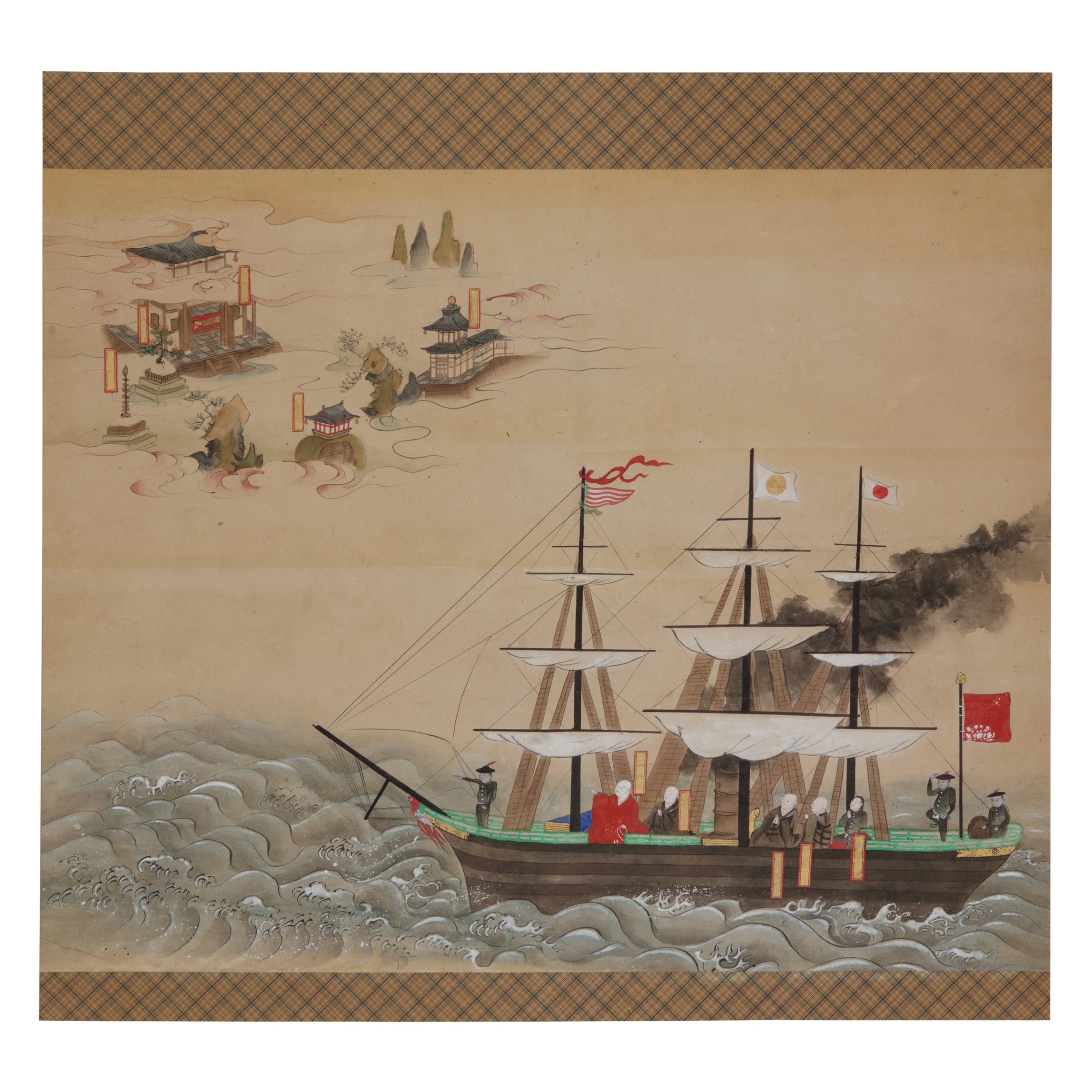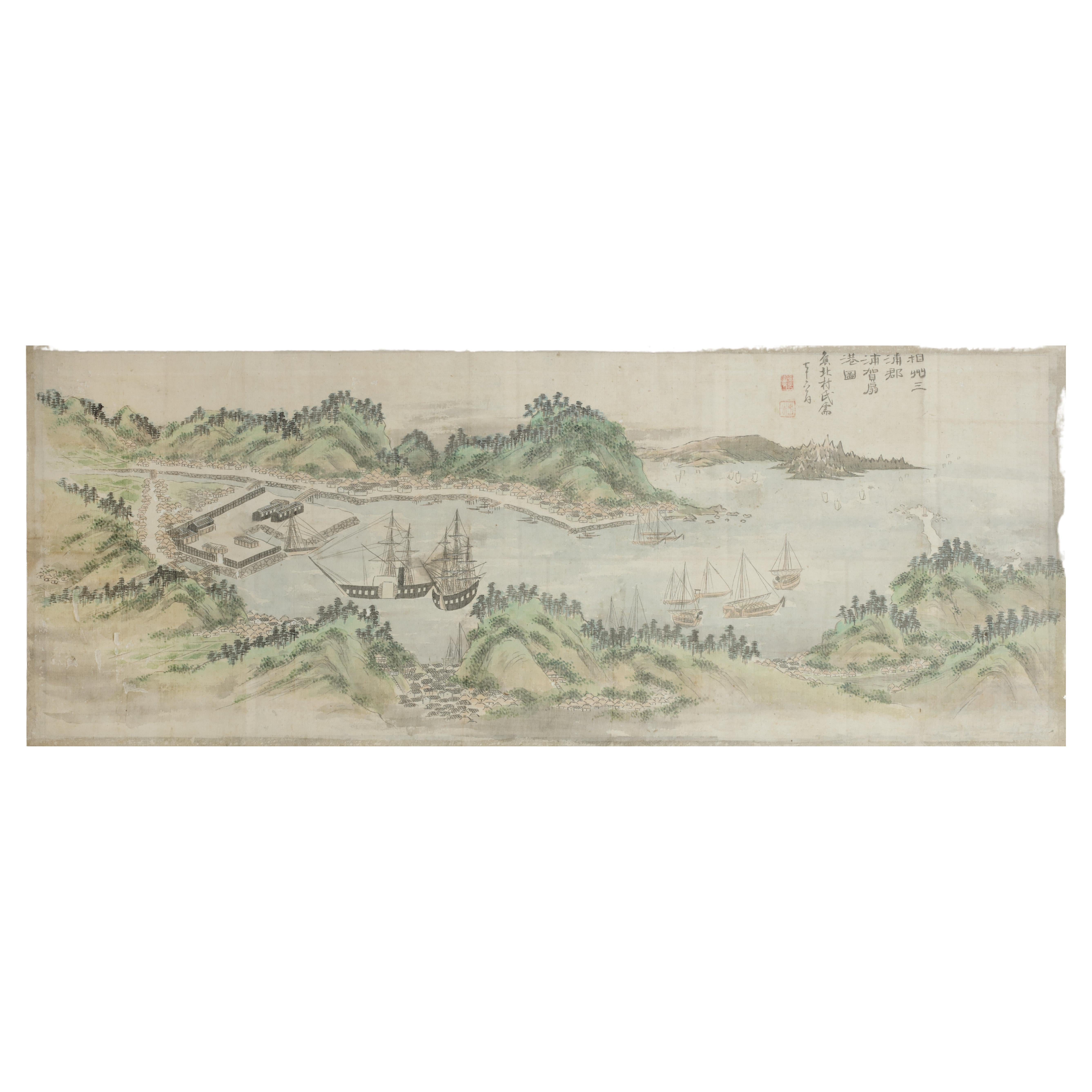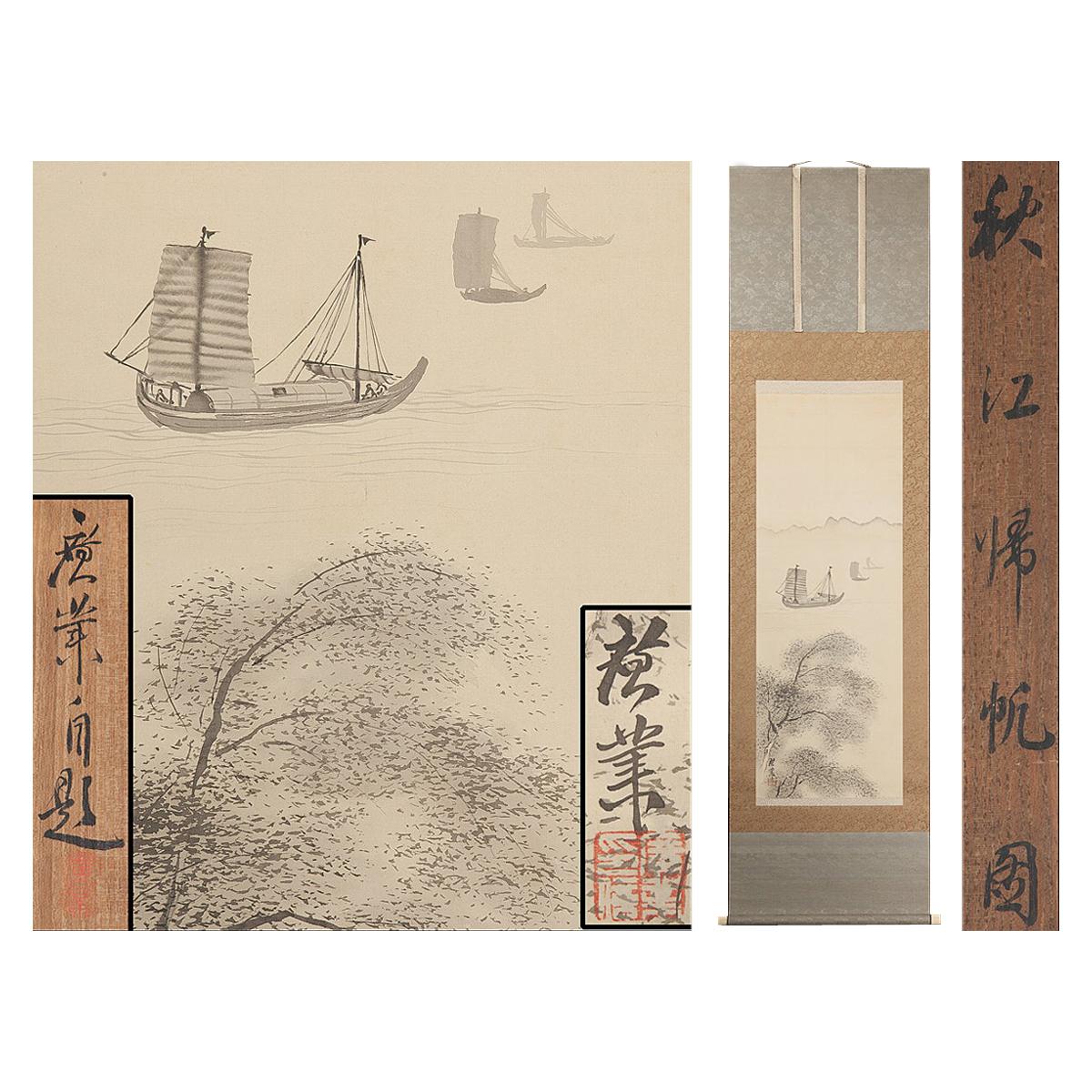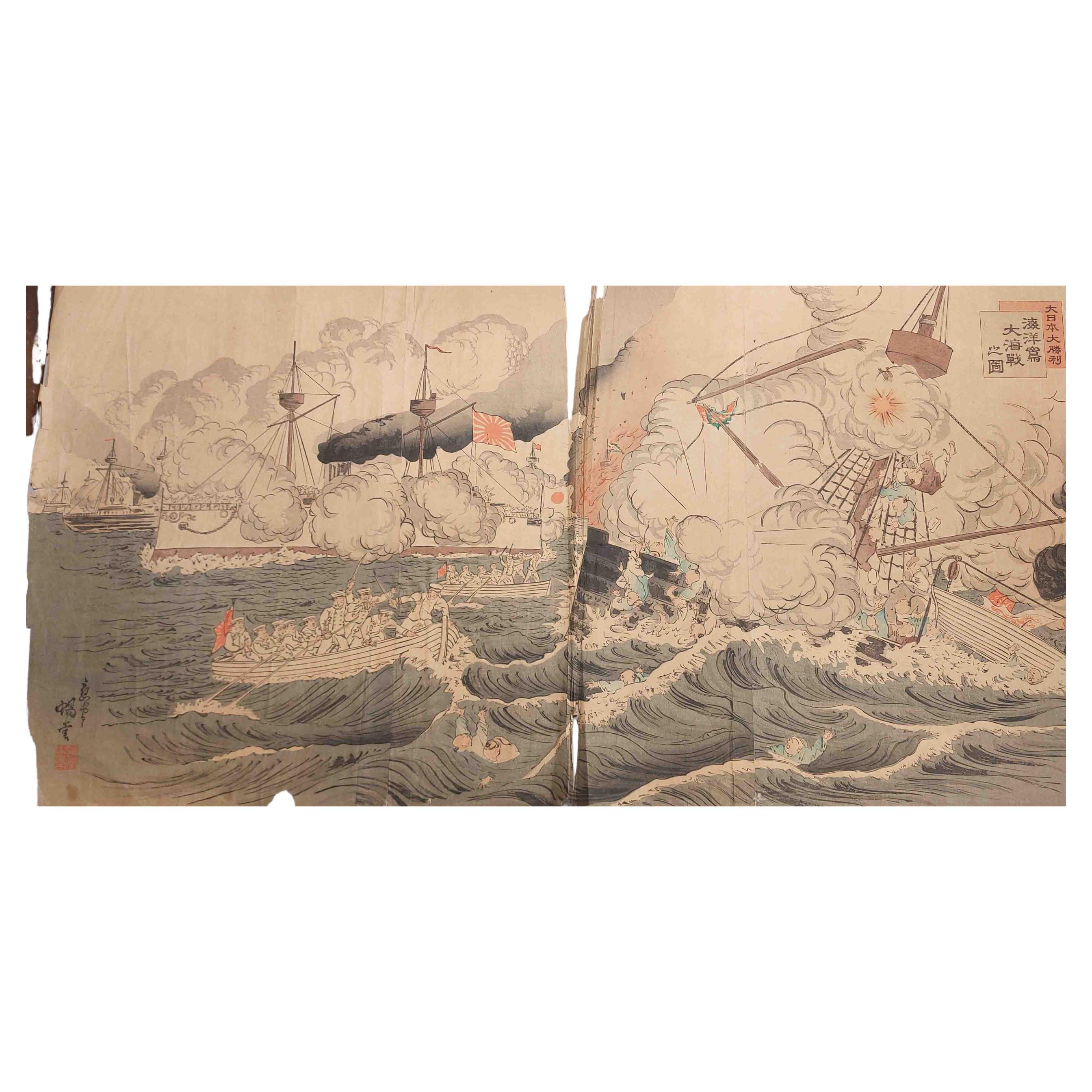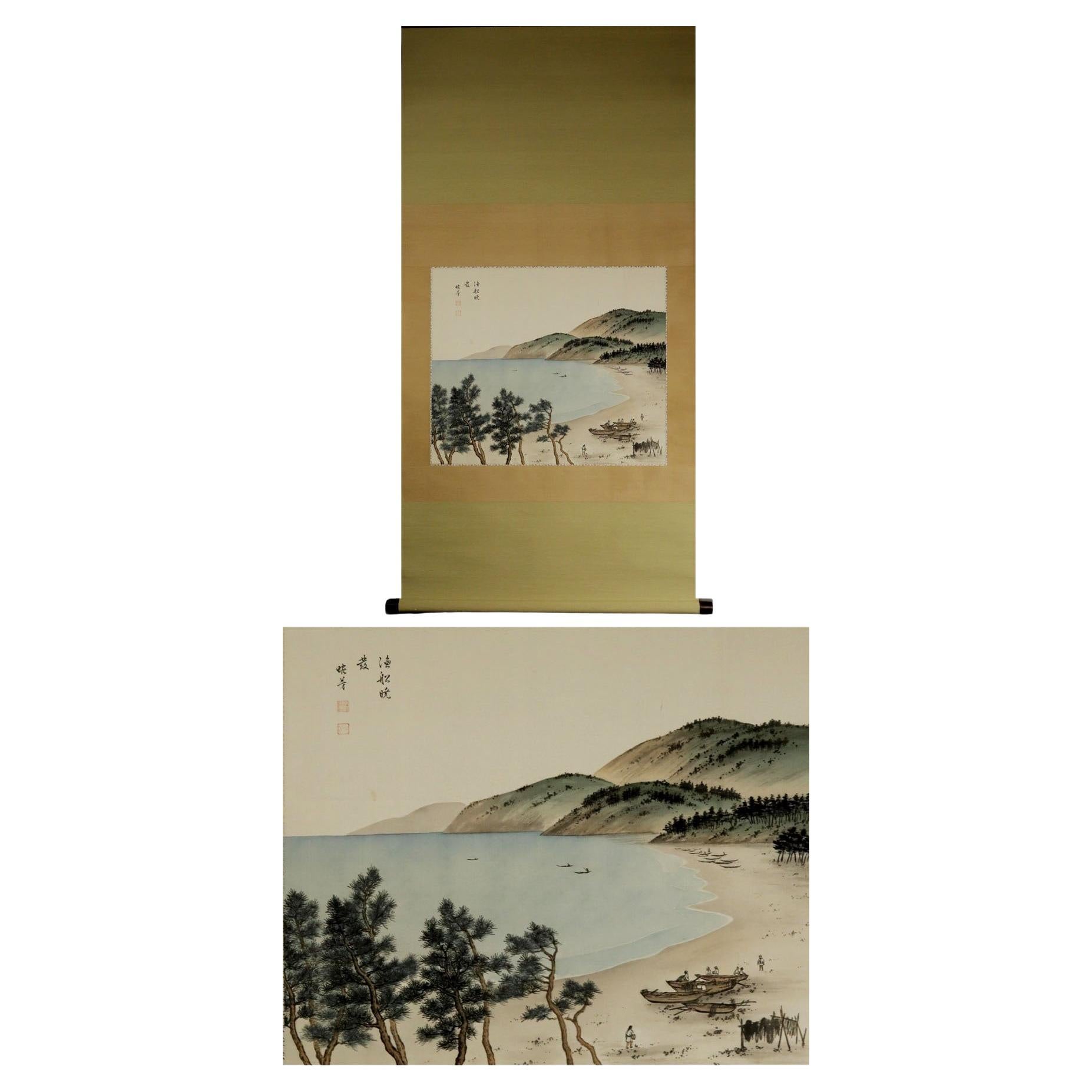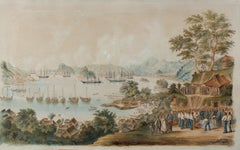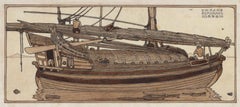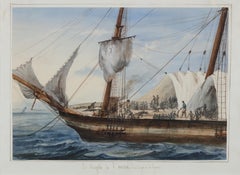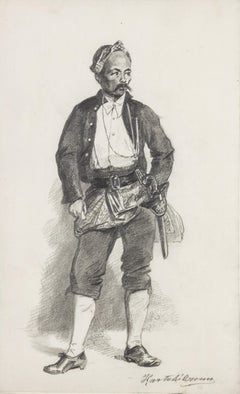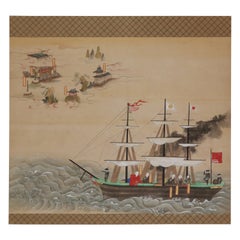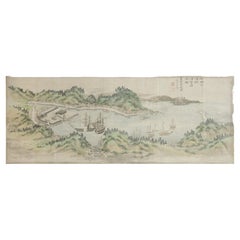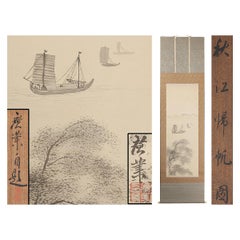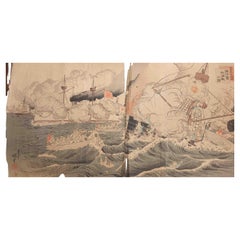Items Similar to Scroll painting of the American ship commanded by Commodore Matthew Perry
Want more images or videos?
Request additional images or videos from the seller
1 of 9
Scroll painting of the American ship commanded by Commodore Matthew Perry1854
1854
Price Upon Request
Price Upon Request
Price Upon Request
Price Upon Request
Price Upon Request
Price Upon Request
Price Upon Request
Price Upon Request
Price Upon Request
Price Upon Request
About the Item
Attributed to Ukita Ikkei (1795-1859)
Hanging scroll painting of the American ship commanded by Commodore Matthew Perry in Uraga Bay, annotated: ‘1854 Spring first month 8 xx (February) Kan-no Hachiro saw this big American wheel vessel past Cape of Kan-non going to Uraga village’
Ink on paper,
L. 130 x W. 29 cm (scroll)
H. 28 x W. 19 cm (painting)
Based on the description by Kan-no Hachiro of the return of Perry’s ship to the bay of Edo in 1854, Ukita Ikkei presumably made this painting. The artist’s family name was Toyotomi and the first name Kõshin later changed to Yoshitame and finally Ikkei.
Kan-no (1810-1880) was a peasant from the village of Iwashiro. In 1854 he saw Perry’s ship passing on the way to Edo Bay. Kan-no was an ardent follower of the Sonno foi Movement, a movement advocating loyalty to the Emperor and the expulsion of foreigners.
Despite his low status, he became a significant and famous figure in the Sonno foi Movement, and for this, he was punished by the Edo Bakufu, the Shogun government. He was banished to Hachijyo, a small island far away in the Pacific Ocean.
Perry’s first violation of Japanese autonomy was on the third day of the sixth month of 1853 (July 8), on the eleventh day of the first month of 1854 (February) he was back in the Bay of Uraga, and on the 31st of March the Convention of Kanagawa, opening the ports of Hakodate and Shimoda to American vessels, was signed.
Literature:
Encyclopedia of Japanese painters, ‘Nihon gaka jiten’ p. 17
- Attributed to:Ukita Ikkei (1795 - 1859, Japanese)
- Creation Year:1854
- Dimensions:Height: 51.19 in (130 cm)Width: 11.42 in (29 cm)Depth: 0.08 in (2 mm)
- Medium:
- Movement & Style:
- Period:
- Condition:
- Gallery Location:Amsterdam, NL
- Reference Number:1stDibs: LU1471210574672
About the Seller
No Reviews Yet
Vetted Professional Seller
Every seller passes strict standards for authenticity and reliability
1stDibs seller since 2021
- ShippingRetrieving quote...Shipping from: Amsterdam, Netherlands
- Return Policy
Authenticity Guarantee
In the unlikely event there’s an issue with an item’s authenticity, contact us within 1 year for a full refund. DetailsMoney-Back Guarantee
If your item is not as described, is damaged in transit, or does not arrive, contact us within 7 days for a full refund. Details24-Hour Cancellation
You have a 24-hour grace period in which to reconsider your purchase, with no questions asked.Vetted Professional Sellers
Our world-class sellers must adhere to strict standards for service and quality, maintaining the integrity of our listings.Price-Match Guarantee
If you find that a seller listed the same item for a lower price elsewhere, we’ll match it.Trusted Global Delivery
Our best-in-class carrier network provides specialized shipping options worldwide, including custom delivery.More From This Seller
View All1854 Funeral of R. Williams at Gyokusen-ji Temple, Shimoda, with Commodore Perry
Located in Amsterdam, NL
Wilhelm Heine (Dresden 30 January 1827-Löbnitz 5 October 1885)
‘Funeral of Robert Williams in the cemetery of the Temple Gyokusen-ji at Shimoda in April 1854’
With a sticker on the reverse of the frame by Coupil & Co. 1855
Watercolour on paper, H. 57 x W. 92 cm
Depicted is the Bay of Shimoda with seven American ships including the two paddle-wheel warships USS Mississippi and Susquehanna. On the Gyokus- en-ji temple grounds on the right is the coffin in the middle with the remains of US marine Robert Williams, ready to be lowered into the grave. Looking on from the left are the Buddhist monks and Japanese officials who joined the first Christian funeral on Japanese soil. Around the grave are US marines, Commodore Perry...
Category
Mid-19th Century Figurative Drawings and Watercolors
Materials
Paper, Ink, Watercolor, Gouache
Price Upon Request
Free Shipping
A Buginese boat, Semarang 1898
Located in Amsterdam, NL
'A Buginese boat, Semarang 1898’
Signed, dated, and annotated, upper right Pen, brush and ink on cardboard, H. 11.4 x W. 26.3 cm
Literature: Venselaar, 2019, p. 69 (ill.)
Category
Late 19th Century Landscape Drawings and Watercolors
Materials
Paper, Ink, Pencil
Portrait of a Slave Ship: 'Le Negrito à l’ancre. Dans le port de la havanne'
Located in Amsterdam, NL
FRANÇOIS MATHURIN ADALBERT, BARON DE COURCY (1805-1839)
'Le Negrito à l’ancre. Dans le port de la havanne'
Indistinctly signed lower left
Titled on the mount
Pencil and watercolour, heightened with white, on paper, 24.8 x 34.6 cm
Literature:
The present watercolour will be illustrated in:
- Prof. Manuel Garcia’s projected book on the disease and the slave trade provisionally titled “Fighting the Yellow Demon of Fever: The Struggle against Disease in the Illegal Slave Trade”.
- Prof. Micael Zeuske’s forthcoming Global history of slave trade.
Exhibited:
Mexico City, 1998, Palacio Virreinal, El Barón de Courcy, illustrationes de un viaje, 1831-1833, no. 108
Note:
Baron de Courcy was in the Caribbean in late 1832 and early 1833, following his tour of Mexico in 1832, on the last leg of his “Grand Voyage...
Category
Mid-19th Century Old Masters Figurative Drawings and Watercolors
Materials
Paper, Watercolor, Gouache, Pencil
European Artist - Indonesian Portraits of Mas Marco Kartodikromo, 1890-1932
Located in Amsterdam, NL
European artist (early 20th century)
Two study portraits of Mas MarCo Kartodikromo (1890-1932)
One inscribed Kartodikromo lower right
Framed in ebonized frame with white mount.
Pe...
Category
Early 20th Century Romantic Portrait Drawings and Watercolors
Materials
Paper, Crayon
A pair of Indonesian Landscapes, by Charles Legrain (19th century)
Located in Amsterdam, NL
Charles Legrain, (19th century)
Two Javanese landscapes
Both signed Legrain Ch. and one dated 1857
Both oil on canvas, size: 95 x 114 cm
In rich gilt-gesso frame.
(2x).
Category
Mid-19th Century Romantic Landscape Paintings
Materials
Canvas, Oil
Beach of Kusambe, Bali 1937
Located in Amsterdam, NL
Four outrigger proa’s on the beach of Kusambe, Bali, 1937
Signed with initials, dated and described with location bottom left
Pencil and ink on paper, 29.7 x 35 cm
In ebonized frame with white mount
WILLEM OTTO WIJNAND NIEUWENKAMP
(1874-1950)
Nieuwenkamp was born on July 27th 1874 in Amsterdam. His father owned sailing ships sailing to Indonesia and hearing the stories of the returning captains evoked in the young Nieuwenkamp an obsession for distant lands and adventure. After a failed attempt by his father to have his son make a career in his business, Nieuwenkamp attended the Academy for Decorative Art in Amsterdam. However, he left within one year to go his own way.
He was an autodidact and a great experimenter with new techniques, particularly in the art of etching. Nieuwenkamp was a very focused man with the discipline of a scientist tempered by the sensitivity of an artist, a lust for adventure, a natural appreciation for ethnic arts and an enormous ambition to tread new paths.
In 1898 he visited Indonesia for the first time and on his second visit in 1903-1904 he went on to Bali and became the first foreign artist to love Bali and the Balinese with a passion. Having secured agreements with several museums in the Netherlands to obtain Balinese art and objects for their collections, Nieuwenkamp immediately started to purchase and order a wide range of ethnographic art and objects from local artists and craftsmen.
Through his drawings and books, he gave an excellent impression of Balinese art and culture at that time. Since 1854 Northern Bali was under Dutch...
Category
1930s Art Nouveau Landscape Drawings and Watercolors
Materials
Paper, India Ink, Pencil
You May Also Like
Japanese Painting Depicting Commodore Perry’s Ship with Buddhist Monks Aboard
Located in Amsterdam, NL
A Japanese painting depicting Commodore Matthew Perry’s flagship USS Mississippi bringing the coffin with the remains of US marine private Robert Williams who died while serving on t...
Category
Antique Mid-19th Century Japanese Edo Paintings and Screens
Materials
Paint, Paper
Unpei Kameyama, 'a View of Black 'American' Ships in the Bay of Uraga Senminato'
Located in Amsterdam, NL
Unpei Kameyama (1821-1899)
A view of black (American) ships in the bay of Uraga Senminato, Miura district, June 1853
The Japanese text reads: ‘The seventy-six old men for the Kitamura-clan, drawn in 1897 on request of Yoshisada Kitamura, Himeji, the black ships which so much changed the fate of Japan, enjoy please this masterpiece by Harima Shonin Bisei who brings back memories of his young days.’
Watercolour on paper, laid down on cardboard, H. 44.5 x W. 115.5 cm
Provenance:
Collection of Yoshisada Kitamura, Himeji
Yoshisada Kitamura (1838-1899), the son of a farmer in the village of Ogawa, in the district of Harimakashikihigashi, studied under Matajiro Otaka and got heavily involved in the anti-Shogunate movement. He was active in several military incidents against the Shogunate. After the Meiji restoration, he served the Meiji government as a local official in the Himeji domain.
Kameyama Unpei was a Confucian scholar, a Shinto priest...
Category
Antique Mid-19th Century Japanese Edo Paintings and Screens
Materials
Paper
Scroll Painting Japanese 19th-20th Century Kōgyō Terasaki Meiji
Located in Amsterdam, Noord Holland
A fabulous landscape by Kogyo Terasaki
1866-1919
Japan painter. Akita prefecture production. Character is Tokusato, Soyama-Agaryunoki, beautiful poetry Yamabito, etc. to another is...
Category
20th Century Japanese Meiji Paintings and Screens
Materials
Bronze
$1,264 Sale Price
25% Off
Antique 19th c Woodblock Print by Sino Japan War Naval Battle Haiyang Island
Located in Amsterdam, Noord Holland
A very strong woodblock print
- Fantastic depiction of the naval Battle of Haiyang Island during the Sino-Japanese War. An explosion rocks a Chinese ship at right, severing the mast...
Category
Antique 19th Century Chinese Meiji Paintings and Screens
Materials
Bronze
$1,281 Sale Price
20% Off
'Two Dutch Ships Anchored in the Bay of Nagasaki' by Kawahara Keiga '1786-1860'
Located in Amsterdam, NL
Kawahara Keiga (1786 - c. 1860)
Two Dutch ships anchored in the bay of Nagasaki
Sumi ink and pigment on silk, H. 27 x W. 41 cm (excl. frame)
Comes framed, see image.
?Based o...
Category
Antique Early 19th Century Japanese Paintings and Screens
Materials
Silk
$102,355
Free Shipping
Nihonga Japanese Painting 1900 Meiji Scroll Fishing Boats at Gyosen Nanga School
Located in Amsterdam, Noord Holland
A drawing of the painting "Gyosen Gyosan" painted by Akifoshi. Also included is the box. This is a tasteful work depicting a fishing boat going fishing at sunrise.
■Silk back, handp...
Category
Antique 19th Century Meiji Paintings
Materials
Silk
$2,312 Sale Price
20% Off
More Ways To Browse
Scroll Painting
Antique Ship Paintings
Hanging Scrolls
Ship Drawing
Watercolor Ships
Perry Brown
19th Century Ship Paintings
Commodore Perry
Mid Century Ship Painting
American 19th Century Watercolors
Ink Scroll
Paintings Of American Ships
Paintings By Perry
Nude Male Model
Watercolors Faces
19th Century Pen And Ink Drawings
Western Drawings
Watercolour Caricatures
